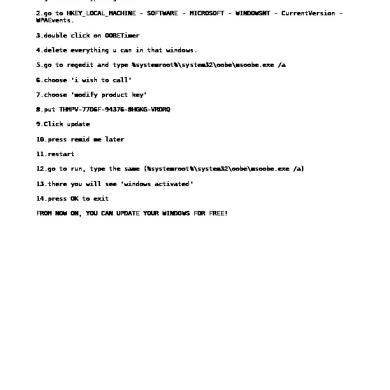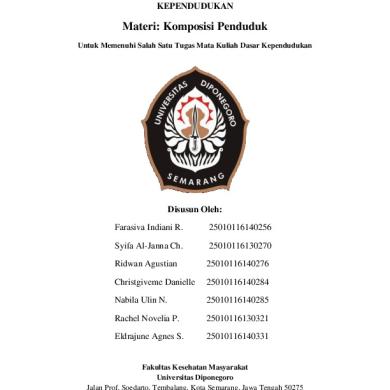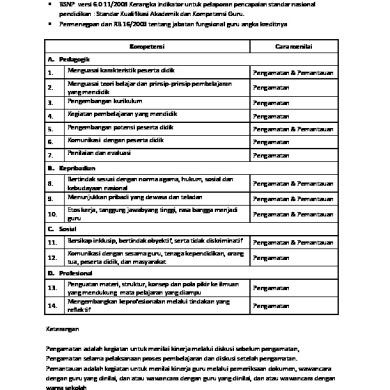Important Terms (base And Derived Quantities)
This document was uploaded by user and they confirmed that they have the permission to share it. If you are author or own the copyright of this book, please report to us by using this DMCA report form. Report DMCA
Overview
Download & View Important Terms (base And Derived Quantities) as PDF for free.
More details
- Words: 318
- Pages: 3
Base Quantities and Derived Quantities Physical Quantity A physical quantity is a quantity that can be measured. Base Quantity Base quantities are the quantities that cannot be defined in terms of other quantities. Derived Quantity Derived quantities are physics quantities derived from the base quantities through multiplication, division or both.
Standard Form and Prefixes Standard form/Scientific Notation Standard form or scientific notation is a convenient way to write very big or very small numerical values in a form of multiple of 10. Prefixes Prefixes are names or symbols that precede a unit of measure to represent very big or very small numerical values in S.I. units.
Scalar Quantities and Vector Quantities Define scalar quantity Scalar quantities are physical quantities that have magnitude only. Define vector quantity Vector quantities are physical quantities that have magnitude and direction.
Measurements
Consistency Consistency is the ability of an instrument in measuring a quantity in a consistent manner with only a small relative deviation between readings. Relative Deviation The relative deviation is the percentage of mean deviation for a set of measurements and it is defined by the following formula: Accuracy The accuracy of a measurement is how close the measurement made is to the actual value of the quantity of physics. Sensitivity Sensitivity of a measuring tool is its ability to detect small changes in the quantity that is being measured. Systematic Error Systematic errors are errors which tend to shift all measurements in a systematic way so their mean value is displaced. Zero Error A zero error arises when the measuring instrument does not start from exactly zero. Random Error Random errors arise from unknown and unpredictable variations in condition. It fluctuates from one measurement to the next.
Parallax Error A parallax error is an error in reading an instrument due to the eye of the observer and pointer are not in a line perpendicular to the plane of the scale.
Standard Form and Prefixes Standard form/Scientific Notation Standard form or scientific notation is a convenient way to write very big or very small numerical values in a form of multiple of 10. Prefixes Prefixes are names or symbols that precede a unit of measure to represent very big or very small numerical values in S.I. units.
Scalar Quantities and Vector Quantities Define scalar quantity Scalar quantities are physical quantities that have magnitude only. Define vector quantity Vector quantities are physical quantities that have magnitude and direction.
Measurements
Consistency Consistency is the ability of an instrument in measuring a quantity in a consistent manner with only a small relative deviation between readings. Relative Deviation The relative deviation is the percentage of mean deviation for a set of measurements and it is defined by the following formula: Accuracy The accuracy of a measurement is how close the measurement made is to the actual value of the quantity of physics. Sensitivity Sensitivity of a measuring tool is its ability to detect small changes in the quantity that is being measured. Systematic Error Systematic errors are errors which tend to shift all measurements in a systematic way so their mean value is displaced. Zero Error A zero error arises when the measuring instrument does not start from exactly zero. Random Error Random errors arise from unknown and unpredictable variations in condition. It fluctuates from one measurement to the next.
Parallax Error A parallax error is an error in reading an instrument due to the eye of the observer and pointer are not in a line perpendicular to the plane of the scale.
Related Documents

Important Terms (base And Derived Quantities)
October 2019 31
Important Terms In Management.docx
April 2020 19
Important Terms (linear Motion)
October 2019 41
Quantities, Units, And Measurement
July 2020 12
Quantities And Units
May 2020 17
Basic Quantities
June 2020 9More Documents from ""

Validate Windows
November 2019 43
Cover Daftar Hadir Pengawas.docx
May 2020 39
Resume Fahrul Kel 2 Dan 3.docx
May 2020 35
Resume Materi Mata Kuliah Dasar Kependudukan.docx
December 2019 51
Lampiran Pkg 2014.docx
May 2020 36